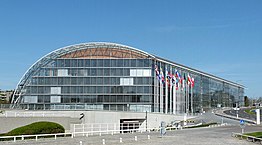European Investment Bank
| European Investment Bank
|
|
|---|---|
| legal form | own legal personality |
| founding | 1958 |
| Seat | Luxembourg |
| management | Werner Hoyer (President) |
| Number of employees | 2,872 (December 31, 2016) |
| Branch | Banks |
| Website | eib.org |

The European Investment Bank ( EIB ) has since its inception in 1958, the task of "contributing to the balanced and steady development of the internal market in the interest of the Union" with their own capital resources (Art. 309 para. 1 TFEU) and operates in this way "economic policies through lending ”. The EIB also operates outside the EU.
The legal basis for their activity is acc. Art. 308 sentence 3 TFEU, the protocol on the statutes of the EIB of 25 March 1957, last amended by the Treaty of Lisbon .
The EIB, with its own legal personality (see Art. 28 Statutes), is not an institution of the European Union, "it stands as a special financial institution alongside the institutions" and is therefore not bound by instructions from the Commission or Parliament, but it does consult them . Together with the European Investment Fund , it forms the EIB Group, founded in 2000 . The capital owners of the EIB are the EU member states.
The subscribed capital of the EIB amounts to 242 billion euros . According to the Articles of Association, at least 5% of this amount is paid in. The EIB raises its funds through borrowing from the credit markets.
founding
The EIB was founded in 1958 on the initiative of the French President Charles de Gaulle together with the EEC and is headquartered in Luxembourg . There are also numerous branch offices.
Funding priorities
As a financing instrument of the European Union, the EIB is committed to the political objectives of the Union under Article 309 of the TFEU and is intended to accompany other EU funding measures. In addition to the EC Treaty, the tasks result from the statutes of the EIB and from mandates that are assigned to it by resolutions of the European Council . It is therefore responsible for granting loans and guarantees to public and private institutions in accordance with the objectives of the Union. The four priority objectives of the EIB in the EU include:
- Regional development and cohesion (i.e. improving intra-European economic and social cohesion);
- Implementation of the Innovation 2010 Initiative (see Lisbon Strategy );
- Expansion of Trans-European Networks (TEN) and access networks;
- Protection and improvement of the environment , etc. a. Climate protection and renewable energies.
Another focus is the support of the EU's development and cooperation policy towards partner countries. Regional priorities are the Mediterranean (the FEMIP program exists here ) and the ACP countries ( Cotonou investment facility ). The “Trust Fund for Technical Assistance in the Eastern Partner Countries” (EPTATF), established in December 2010, provides project-based support for the countries of the Eastern Partnership . Students in their main studies can also apply for funding under the program.
In the context of EU external relations, the EIB is also responsible for the financial implementation of development cooperation agreements on the basis of various ad hoc EU mandates.
On November 14, 2019, the Board of Directors of the EIB adopted a new financing policy in the energy sector in order to bring the EIB’s financing into line with the climate protection goals of the Paris Agreement . From the end of 2021, the EIB will no longer finance new fossil energy projects without CO 2 reduction.
Financing for new projects by the EIB was in danger of being cut by 50% in the wake of Brexit at the end of January 2020, but the other EU countries agreed to provide the share of around 40 billion euros previously borne by the United Kingdom. In addition to the withdrawn British cash deposits of around 3.5 billion euros, this also includes callable capital of around 38 billion euros.
structure
The bodies of the EIB are:
- Board of Governors
- The Board of Governors is composed of the competent ministers of the member states, usually the finance ministers. Together they set the guidelines for the credit policy, approve the annual balance sheet and the profit and loss account, approve the participation of the bank in financing outside the Union and decide on capital increases . They also appoint the members of the other committees. The current chairman is Paweł Szałamacha .
- Board of Directors
- The board of directors is responsible for deciding on loans and guarantees. He ensures the proper administration of the institute and compliance with the legal provisions ( EC Treaty ), the EIB statutes and the guidelines of the Council of Governors. 27 members are appointed by the member states, one member is a representative of the European Commission . The term of office is five years and re-appointment is permitted. Up to six experts with voting rights can be appointed. The members do not receive any remuneration, only attendance fees. The German Werner Hoyer has been the chairman since the beginning of 2012 .
- Directory
- The nine-member Board of Directors is the EIB's executive body. Under the supervision of the President and controlled by the Board of Directors, it conducts day-to-day business, prepares the decisions of the Board of Directors and ensures their implementation. The term of office is six years and re-appointment is permitted.
- Examination Board
- The independent audit committee monitors the proper execution of transactions and reviews the bank's books. He reports to the Board of Governors. The committee has three members and three observers appointed by the Board of Governors for three years.
Working method
On the one hand, the capital of the EIB is provided by the member states by subscribing shares in the EIB according to their economic performance ( gross domestic product ). On the other hand, it raises extensive funds on the capital markets by issuing bonds . As the member states own the bank, it has an excellent rating (AAA) on the international financial markets . Eligible projects are usually financed up to 50% of the total amount, which is made available on favorable terms (e.g. low interest rates ). The investment objectives are set by the EIB in an “overall operational plan” for a period of three years. The EIB prepares an annual report on its activities.
In 2011 the EIB signed new loans totaling EUR 61 billion for projects in nearly 70 countries. Of this, € 54 billion was lending within the European Union and € 7 billion outside the EU. Payouts reached EUR 60 billion. The EIB has thus supported the real economy more strongly than ever before.
The EIB is represented in the Standard Committee of SuRe®. SuRe® is a global standard for sustainable infrastructure that is currently being developed by the Swiss Foundation Global Infrastructure Basel and the French bank Natixis .
See also
- Development bank
- European Bank for Reconstruction and Development
- European Investment Fund
- EU funding programs
Web links
- Official website of the European Investment Bank
- The files of the European Investment Bank are deposited in the Historical Archives of the EU in Florence
- Information from Europa Digital
- European Investment Fund
Individual evidence
- ↑ Cf. New President of the European Investment Bank: Werner Hoyer. European Movement Germany , January 4, 2012, accessed January 4, 2012 .
- ↑ EIB Financial Report 2016
- ^ Oppermann , Classen , Nettesheim : European law. 4th edition. Beck , Munich 2009, ISBN 978-3-406-58768-9 , p. 340, Rn. 32.
- ^ Oppermann, Classen, Nettesheim: European law. 4th edition. Beck, Munich 2009, p. 340, Rn. 32, 42.
- ^ Oppermann, Classen, Nettesheim: European law. 4th edition. Beck, Munich 2009, p. 340, Rn. 32
- ↑ consisting of the IEB and the European Investment Fund (EIF), which supports small and medium-sized enterprises (SMEs) in particular
- ↑ European Investment Bank: The most important figures
- ↑ Trust Fund for Technical Assistance in the Eastern Partner Countries (EPTATF) , retrieved on 10 February 2016.
- ↑ Bank of the EU: ambitious climate strategy and new financing policy in the energy sector. In: EIB. November 14, 2019, accessed November 15, 2019 .
- ↑ Phil Thornton: "EU member states avert € 100bn Brexit 'disaster' for European Investment Bank as UK quits" independent.co.uk of February 3, 2020
- ↑ SuRe® Standard Committee - Global Infrastructure Basel. In: www.gib-foundation.org. Retrieved October 12, 2016 .
Coordinates: 49 ° 37 ′ 13 ″ N , 6 ° 8 ′ 15.3 ″ E
